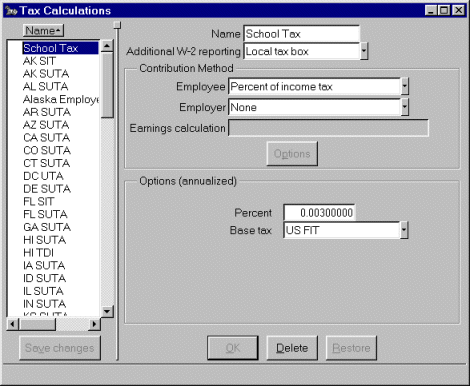21st Century Accounting Tutorials - Payroll
How do I set up Payroll Tax Calculations factors?
When you set up Payroll from scratch, use the Tax Calculations window only if user-defined Taxes apply to your employees or if you want to edit the SUTA maximum Taxable earnings. Set up Tax Calculations factors fifth, after Income, Taxes, Noncash Benefits, and Accruals. Of course, you can modify and add Tax Calculations factors at any time.For more information at any field in the window, press F1: Help.
Follow these steps to set up a user-defined Tax.
- Run Payroll/Configure/Tax Calculations.
- Highlight <new>, press the Tab key, and enter a meaningful name for the user Tax.
- Select the appropriate W-2 box for "Additional W-2 reporting." The default of "None" at "Additional W-2 reporting" is correct for Taxes supported by the Payroll Tax Updates. User-defined Taxes may have other requirements for W-2 reporting such as Local Tax box or Other information box. Review your W-2 instructions if you are in doubt.
- Select the "Contribution method" you want the system to use to calculate the employee Tax and, if appropriate, the employer contribution.
"Earnings calculation" lets you set up the earnings base -- straight earnings, earnings minus exemptions, and so forth. Select from the drop-down list.
Click the Options button to display the prompts associated with the contribution and Taxable earnings calculation methods in the Options part of the window below.
You assign posting accounts when you assign a Tax to a company in Configure/Taxes. In this window, you enter the calculation information.
- User-defined Taxes may require maximum and minimum earnings levels to kick in. They may require Tax ceilings. You will need to enter such additional information the system uses to calculate the Tax.
- Click OK to save your work so far.
Here is how a completed Tax Calculations window might look.

- Click Save changes to save the factor.
